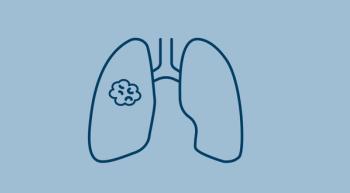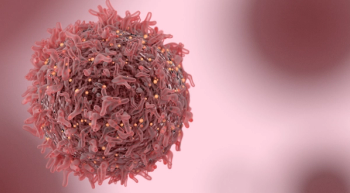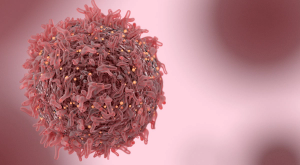
The combination of odronextamab with CHOP chemotherapy showed early efficacy in patients with untreated diffuse large B-cell lymphoma.

Silas Inman, Senior Vice President, Content, joined MJH Life Sciences™ in early 2011 as one of the company's first web editors. In this position, he built OncLive.com from a fledgling web platform to a leading source of oncology news for community oncologists via in-depth reporting of breaking news from major medical conferences and the launch of OncLive® TV.
Throughout his tenure at MJH, Silas has been accountable for several organic launches of highly successful brands and for quickly transforming acquisitions into high-functioning business units. Prior to joining MJH, Silas, who attended Eastern Michigan University, was an EMT, frontend web developer, and social media/SEO expert. Follow him on Twitter @SilasInman or email him at sinman@mjhlifesciences.com

The combination of odronextamab with CHOP chemotherapy showed early efficacy in patients with untreated diffuse large B-cell lymphoma.

The ROR1-targeted ADC plus R-GemOx led to a 56.3% ORR in patients with relapsed or refractory diffuse large B-cell lymphoma in waveLINE-003.

The combination of niraparib with abiraterone acetate and prednisone (AAP) boosted rPFS vs AAP plus placebo in HRR-mutated mCSPC.

Initial therapy with isatuximab plus VRd followed by its addition to Rd maintenance therapy led to significantly improved MRD negativity and PFS in transplant-ineligible multiple myeloma.

“By addressing these issues, we can ensure that all patients, regardless of their socioeconomic status, have the opportunity to benefit from potentially curative treatments,” one expert says.

Patients with recurrent ovarian cancer did not derive a benefit from adding atezolizumab to chemotherapy and bevacizumab.

These data may support belantamab mafodotin, bortezomib, and dexamethasone as a new standard of care for patients with relapsed/refractory multiple myeloma.

Adding inavolisib to palbociclib and fulvestrant improved results for HER2-negative, hormone receptor–positive, PIK3CA-mutated advanced or metastatic breast cancer.

The combination given before lymph node dissection and response-driven adjuvant therapy reduced the risk for recurrence, progression, or death in stage III melanoma.

Reducing the dose of talquetamab, a GPRC5D/CD3 bispecific antibody, may improve side effect rates while maintain high response rates in patients with relapsed or refractory multiple myeloma.

Adding navitoclax to ruxolitinib improved spleen volume reduction, but not total symptom score in patients with myelofibrosis.

A total of 58.5% of patients who received luspatercept remained red blood cell (RBC) transfusion independent for 12 weeks or more.

Overall survival data from the phase 3 ADUARA trial has further supported the use of osimertinib to treat EGFR-mutant non–small cell lung cancer in the adjuvant setting.

As evidence begins to mount supporting the efficacy of antibody-drug conjugates (ADCs), it is important that clinicians increase their knowledge of ADCs to improve the delivery of these agents.

Vorasidenib reduced the risk of progression or death by 61% compared with placebo for patients with grade 2 IDH-mutant glioma.

Pembrolizumab before and after resection improves event-free survival outcomes for patients with early-stage NSCLC, according to findings from KEYNOTE-671.

Adding induction to standard chemoimmunotherapy followed by autologous stem cell transplantation and maintenance ibrutinib was highly effective in patients with mantle cell lymphoma.

Zanubrutinib demonstrated a superior reduction in the risk of progression or death for patients with relapsed or refractory chronic lymphocytic leukemia or small lymphocytic lymphoma compared with ibrutinib.

Heavily pretreated patients with Waldenström macroglobulinemia demonstrated encouraging responses with pirtobrutinib, a non-covalent BTK inhibitor.

In the second line setting, lisocabtagene maraleucel (liso-cel; Breyanzi) significantly reduced the risk of an event for patients with high-risk relapsed/refractory large B-cell lymphoma, compared with standard-of-care chemoimmunotherapy induction.

Patients with metastatic non-squamous non–small cell lung cancer who received frontline dostarlimab (Jemperli) plus chemotherapy experienced a risk of disease progression or death that was 30% greater than that experienced with pembrolizumab (Keytruda).

Sotorasib doubled the progression-free survival rate in patients with KRAS G12C–mutated non–small cell lung cancer.

At a median follow-up of 33.0 months, the median progression-free survival with tumor-infiltrating lymphocyte therapy was 7.2 months vs 3.1 months with ipilimumab.

The relapse-free survival rate was 22.3% among patients with resectable stage IIIB to IV M1a melanoma who received neoadjuvant talimogene laherparepvec versus 15.2% among those who received surgery alone.

Findings from DESTINY-Breast04 (NCT03734029) support the use of trastuzumab deruxtecan in patients with hormone receptor–positive, HER2-low metastatic breast cancer.

Updated safety findings from DESTINY-Breast03 showed that treatment with trastuzumab deruxtecan was safe and tolerable for patients with HER2-positive metastatic breast cancer.

Real-world findings presented at the 39th Annual Miami Breast Cancer Conference showed that eribulin may be an effective agent for previously treated patients with metastatic breast cancer.

At this point, the number of new confirmed cases of coronavirus infection seems to change every day, with more than 100,000 infections reported worldwide.

At the 2019 European Society for Medical Oncology, new study results showed promise for a frontline combination therapy for patients with newly diagnosed, advanced ovarian cancer.

Optimizing the methods for preclinical research with an emphasis on patient-derived models, may help speed up the translation of new treatment advances from the laboratory to the clinic, according to a presentation by Charles M. Rudin, MD, PhD, at the 2019 International Lung Cancer Congress.

Published: January 12th 2023 | Updated:

Published: September 20th 2022 | Updated:

Published: December 25th 2022 | Updated:

Published: June 5th 2022 | Updated:

Published: September 24th 2022 | Updated:

Published: June 6th 2022 | Updated: